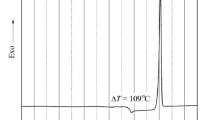IR spectroscopy was used to study the behavior of water in model glasses of the systems Na2O–B2O3–SiO2 and K2O–B2O3–SiO2. It was determined that hydroxyl groups and water in molecular form are present in such alkali borosilicate glasses obtained by quenching water-bearing melt. The water distribution between its forms and silicate and borate components of the glass structure depends on their chemical composition. Proton-cation exchange with the participation of non-bridge oxygen atoms and coordinated alkali-metal ions is involved in the process leading to the formation of hydroxyl groups.


Similar content being viewed by others
References
D. K. Priest and A. S. Levy, “Effect of water content on corrosion of borosilicate glass,” J. Am. Ceram. Soc., 43(7), 356–358 (1960).
K. Ferrand, A. Abdelouas, and B. Grambow, “Water diffusion in the simulated French nuclear waste glass SON 68 contacting silica rich solutions: experimental and modeling,” J. Nucl. Mater., 355(1–3), 54–67 (2006).
D. Rebiscoul, F. Rieutord, F. Ne, P. Frugier, et al., “Water penetration mechanisms in nuclear glasses by x-ray and neutron reflectometry,” J. Non-Cryst. Solids, 353, 2221–2230 (2007).
M. B. Épel’baum, M. A. Ivanov, and E. V. Fokeev, “Multi-ampoule high gas pressure setup with a revolving apparatus for fast quenching,” in: Essays on the Physical-Chemical Petrology [in Russian], Nauka, Moscow (1991), Issue 17, pp. 141–144.
E. M. Stolper, “The specification of water in silicate melts,” Geochim. et Cosmochim. Acta, 46(12), 2609 – 2620 (1982).
J. E. Shelby, “Diffusion and solubility of water in alkali borate glasses,” Phys. Chem. Glasses, 44(2), 106–112 (2003).
V. E. Eremyashev and L. A. Shabunina, “Effect of the parameters R and K on the particulars of the anionic structure of alkali borosilicate glass,” Vestn. YuUrGU, Khim., No. 6 (2011).
A. G. Simakin, V. E. Eremiashev, and T. P. Salova, “Mechanism of water solubility in glasses albite-netheline system,” Mineralogy and Petrology, 99(3–4), 279–285 (2010).
J. Wan, J. Cheng, and P. Lu, “The Coordination State of B and Al of Borosilicate Glass by IR Spectra,” J. Wuhan Univ. Technol. Mater. Sci. Ed., 23(3), 419–421 (2008).
T. Xiu, Q. Liu, and J. Wang, “Alkali-free borosilicate glasses with wormhole-like mesopores,” J. Mater. Chem., No. 16, 4022–4024 (2006).
Author information
Authors and Affiliations
Corresponding author
Additional information
Translated from Steklo i Keramika, No. 10, pp. 29 – 33, October, 2012.
Rights and permissions
About this article
Cite this article
Eremyashev, V.E., Shabunina, L.A. & Salova, T.P. Behavior of water in sodium and potassium borosilicate glasses. Glass Ceram 69, 346–349 (2013). https://doi.org/10.1007/s10717-013-9476-y
Published:
Issue Date:
DOI: https://doi.org/10.1007/s10717-013-9476-y




